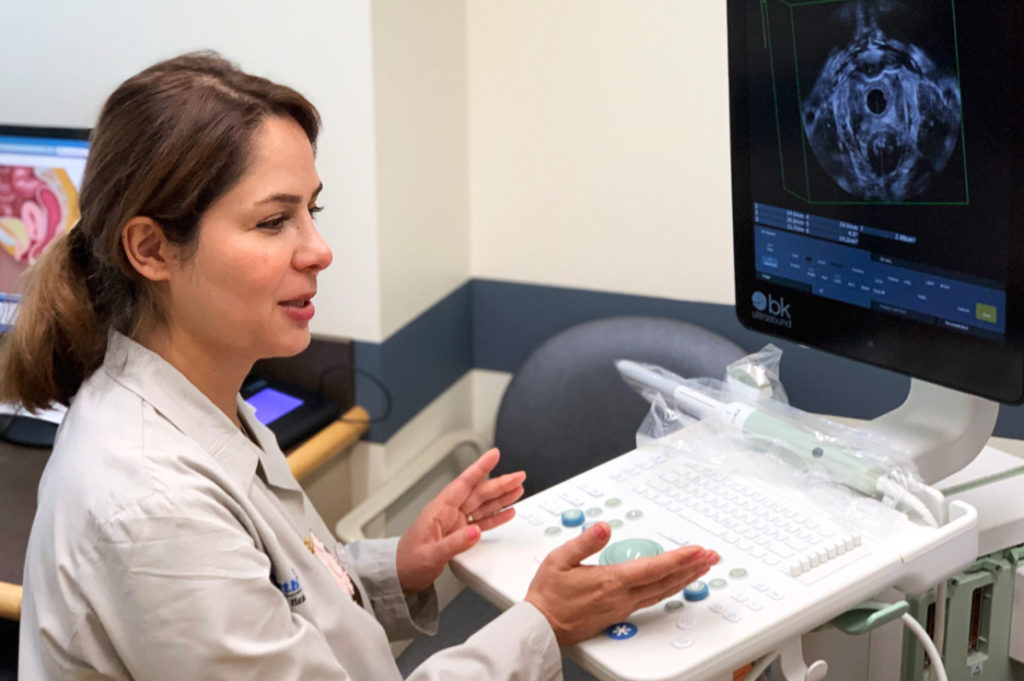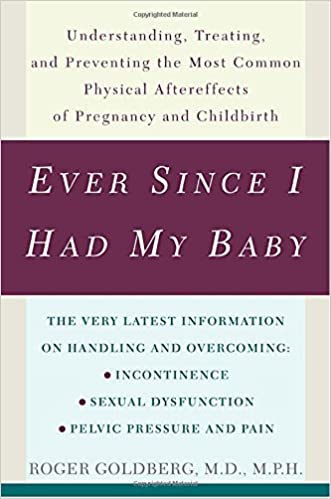Body after Baby: Our Postpartum Pelvic Floor Clinic
Bladder, bowel, pelvic support and even sexual changes are common after childbirth, but are not inevitable. Our Body after Baby Clinic provides an early and accurate diagnosis, maximizing your ability to get your body back.
Whether childbirth is easy or difficult, long or short, one reality remains constant: a woman’s body will never be exactly the same after pregnancy, labor and delivery, as it was beforehand.
The good news? For most women these physical changes are subtle and create no problems. But if you’ve reached this website, it’s likely you have noticed some sort of physical change, and you’re looking for answers and relief. Or maybe you’re planning ahead for delivery, and need advice on a birth plan that will leave your body in the best shape possible. We are constantly thinking about, researching and improving care in all of these areas. Let’s put that knowledge to work, for you.
Changes You May Experience After Childbirth
- My bowels don’t work the same as before having kids
- Everything feels “loose” and “lower”. I want my body back!
- Intercourse hurts, or just doesn’t feel the same
- My episiotomy never healed quite right
- I’m having a baby soon, how can I protect my body and prevent future problems?
Our Body After Baby Clinic Can Address
Perineal Injuries and Episiotomies
During childbirth, as the baby is delivered, in up to 75% of women the perineum — meaning the skin and muscles that span between the vagina and rectum — can tear spontaneously or be cut purposely with an episiotomy. Perineal tears can be partial, or they can be complete, extending all the way through the muscles and even into the rectum.
If the perineum is torn during childbirth, even with a proper repair, the perineal muscles and tissue may not properly heal. Any or all of the perineal muscles can become separated, creating a gaping appearance to the vaginal opening, sometimes even pain. Severe perineal injuries sometimes heal adequately on their own, but in other cases may benefit from an examination to ensure proper healing, pelvic muscle rehabilitation, and in some cases an outpatient surgical revision.
Deeper “Hidden” Pelvic Muscle Injuries
Remarkably, up to 80% of women after vaginal childbirth may have occult (hidden) injuries to the pelvic muscles. These injuries can sometimes be detected during a careful examination of the pelvic floor muscles, but can be even more clearly diagnosed using pelvic floor ultrasound.
Understanding these injuries and getting started with postpartum physical rehabilitation will provide your best odds for regaining your best function, and avoiding bigger problems down the road.
Changes in Bladder Control
Up to 50% of childbearing women will experience some worsening of bladder control or function by age 40. For many of these women, symptoms arise shortly after childbirth, whereas for others it may take years or even decades for childbirth injuries, compounded by ‘wear and tear’ of daily life, to cause symptoms.
Bladder problems today are not an inevitable result of motherhood. While that may have been the case for your mother or grandmother, those times have passed! We have many ways to help get this key part of your body back in control, and restore your quality of life. We’re eager to help you get started.
Changes in Bowel Function and Control
For many women childbirth may involve injury to the anal sphincter, and/or other nearby pelvic floor muscles and tissues that help to maintain normal bowel control and function. When these structures are injured, the damage is sometimes obvious; in other cases, changes can only be appreciated using ultrasound.
If you’ve developed new issues in this area — such as accidental bowel leakage, constipation or difficulty completing bowel movements, then you’ll likely benefit from an evaluation. We start with a careful examination and dynamic 3D pelvic ultrasound, and will then lay out your best path to the fullest recovery. Investing in your ‘pelvic rehab’ can help to improve your future quality of life, comfort and control.
Sexual Changes and Painful Intercourse
Pregnancy and childbirth result in some degree of stretching and change to the pelvic and vaginal tissues, for many women. Clearly, the degree and type of change to the vagina and pelvis may be influenced by whether you had a vaginal birth or cesarean, large versus small baby, and also depend on whether certain interventions (such as forceps or episiotomy) took place.
If you feel “things changed” in your sex life after having a baby — whether it’s loss of vaginal tone, reduced sensations, or painful intercourse — then it might be time for an evaluation. Our evaluation will include assessment for proper healing, identification of any specific injuries that may need attention, pelvic muscle strengthening, and individualized recommendations such as hormone creams.
If surgery is eventually needed for vaginal pain, stretching or looseness that don’t improve with natural strategies, our team will be ready to help.
3D Pelvic Ultrasound: Understand your New Pelvic Floor
3D pelvic ultrasound allows us to see exactly what is happening within the deeper layers of your pelvic floor, that can’t be assessed during a regular exam. This test takes around 10 minutes in the office and provides a vivid image of your pelvic anatomy and it’s muscle and support structures, and usually eliminates the need for MRI or CT testing in the hospital.
You’ll have an immediate improved understanding of any injuries that may be contributing to symptoms. And this information often proves to be invaluable as we develop a recommended treatment plan.
Dr. Rostami, a widely published expert in the field of pelvic floor ultrasonography, helps to oversee our advanced imaging unit, keeping us on the forefront of this technology.

Postpartum Physical Therapy & Rehabilitation
We work closely with a dedicated core of female pelvic floor physiotherapists, all of whom are subspecialty trained in pelvic muscle rehabilitation. Our pelvic floor PT’s routinely help our patients achieve amazing results, alleviating and sometimes fully eliminating a variety of bothersome postpartum symptoms — whether it involves loss of muscle tone, muscle spasm and/or pain, urinary or bowel incontinence, even sexual dysfunction.
Pelvic floor physiotherapy is a very common first step for many women experiencing postpartum symptoms, and within our integrated healthcare system we communicate seamlessly and frequently with these providers to track your progress.
“Preventive Obstetrics”: Develop a birth plan that takes you into account
Seat belts, sunscreen, blood pressure monitoring: all are great examples of front-end planning, to prevent problems. In women’s pelvic health, we haven’t yet developed the perfect “sunscreen for the pelvis” to keep each woman’s body free from injury after childbirth. On the other hand, there’s much that can be done!
We believe that for a generation of women increasingly determined to prevent disease, and maintain vigor rather than quietly accept the physical marks of childbirth and aging, the notion of preventive obstetrical care is long overdue. Whether you’re looking ahead to your first delivery, or looking back on delivery and wondering whether the next pregnancy should be different, we are ready to help you understand and outline the best strategy — one that takes into account not only a healthy baby, but also a confident and healthy mom over the long run.
“Ever Since I Had My Baby”: The Book
Dr. Goldberg’s “Ever Since I Had My Baby” (Three Rivers Press, Random House, 2006) was the first mass-market book on post-reproductive pelvic floor issues written for the layperson. This resource reflects our center’s dedication to educating women on these often ignored topics, and our goal to reimagine obstetrical and postpartum care in a way that takes mom’s body, health and future function into account. Complimentary books are often available at our center for patients looking for a deeper dive into these important health topics. Feel free to ask for a copy.
Who We’ve Helped
Another doctor that keeps me at NorthShore. Very kind and very caring to his patients. Thank you.
My procedure was a repeat surgery and involved a high level of complexity. This was the reason I traveled from out-of-state to specifically see Dr. Goldberg. I felt I couldn’t be in better hands and am delighted with my recovery.
Being a nurse of many years can be problematic in that some providers think “I know everything” and I certainly don’t. Dr. Dutta explained everything in detail, which was very helpful to me because I don’t know much about my problem except what I can find on the internet. She was amazing.
Contact Us
Let’s get you feeling like yourself again.
From scheduling a telemedicine consultation to helping you arrange travel before and after your treatment, we are here to support you at every step. Reach out with questions or to get started.
